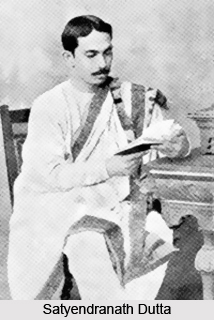 Satyendranath Dutta was a celebrated Bengali poet who was honoured as the wizard of rhymes. His expertise encompassed a number of disciplines of intellectual enquiry such as mythology, culture and medieval Indian history. He was also accredited as the first poet to use Persian and Arabic words in poems which greatly augmented the versatility of Bengali language. He also did translation works of French, English, Japanese, Chinese, Persian and Arabic poems providing the Bengali readers a flavour of foreign poetry and metres. His contribution in bridging the gap between the Bengali and world literatures has been commendable.
Satyendranath Dutta was a celebrated Bengali poet who was honoured as the wizard of rhymes. His expertise encompassed a number of disciplines of intellectual enquiry such as mythology, culture and medieval Indian history. He was also accredited as the first poet to use Persian and Arabic words in poems which greatly augmented the versatility of Bengali language. He also did translation works of French, English, Japanese, Chinese, Persian and Arabic poems providing the Bengali readers a flavour of foreign poetry and metres. His contribution in bridging the gap between the Bengali and world literatures has been commendable.
Early Life of Satyendranath Dutta
Satyendranath Dutta was born on 11th February 1882 at Nimta in North 24 Parganas district, West Bengal, to Rajaninath Dutta who was a trader by profession. His father hailed from the village of Chupi in Burdwan. His grandfather Akshay Kumar Datta, was a prominent Brahmo social reformer and writer. He was also the guiding spirit of the Tattwabodhini Patrika. Satyendranath Dutta completed his schooling from Central Collegiate School in 1899 and joined the General Assembly`s Institution in Kolkata, presently known as Scottish Church College, for graduation. Although he left the institution before completing his course, his training in the institute helped him greatly in his future endeavours. Subsequently he joined his family business to help his father but soon quitted it to devote himself entirely for scholarly pursuits.
Literary Works of Satyendranath Dutta
Satyendranath Dutta began his literary career by composing poem for the Bengali magazine titled Bharati. His initial style of writing previously reflected the influences of renowned poets like Debendranath Sen, Akshay Kumar Boral and Michael Madhusudan Dutt. In the later stage his works derived inspirations from the poetries of Rabindranath Tagore. However in spite of this, the poet successfully maintained his distinct style of poetry. Satyendranath Dutta had written with a number of pseudonyms such as Kalamgir, Tribikram Varman, Ashitipar Sharma, Kaviratna and Nabakumar. His material skill was highly appreciated as he had devised numerous metres keeping the sound system and phrases of Bangla intact. For this he was also regarded as the king of metres or the magician of metrics. In 1918 the Baishakhi number of the Bharati published his well known essay named Chhanda-sarasvati on metrics. His poetries mostly revolved around themes like worship of power, tradition, humanism and patriotism. His compositions were also based on the lower classes of the society including the sweeper community. As an honour to his cherished literary works, a street in South Kolkata has been named after him.
Death of Satyendranath Dutta
Satyendranath Dutta died at the age of 40, on 25th June 1922. After his death the great poet has been immortalized in a poem authored by Rabindranath Tagore.



















